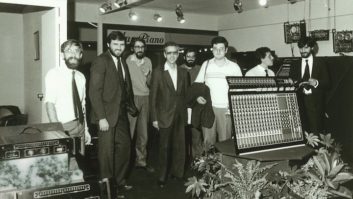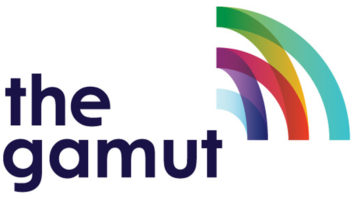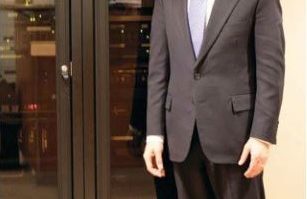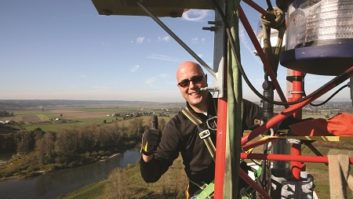Andy Skotdal, president of S-R Broadcasting Co. Inc., owner of KRKO, Everett, Wash., has had perhaps the most challenging ordeal of any broadcaster trying to move and improve a legacy AM service for his community.
Skotdal’s NAB Show presentation is titled, “KRKO(AM): 50,000 Watt Upgrade, Antenna Destruction, Reconstruction and 50 kW Diplex.” It is part of the Radio Engineering Forum on Tuesday morning of the Broadcast Engineering Conference, which offers a rich variety of real-world experiences dealing with difficult circumstances.

The new Nautel XR-50 is hoisted into the transmitter building, which is raised to avoid flood waters. For more than 11 years, Skotdal has had to surmount remarkable odds and resistance, battling neighbors, their attorneys, the local airport, the state and county governments, environmental preservation agencies and societies of various kinds — and, finally, a domestic terrorist. He’s done this in one of the most environmentally sensitive and politically progressive areas of the country.
Manage the clock
Skotdal will first offer an overview of the original effort expended to make the move.
After finding and acquiring an appropriate location and parcel of land, the company spent eight years securing the necessary permits and finally constructing the new KRKO on the Snohomish River flood plain east of Everett. KRKO’s 50 kW four-tower facility was completed and commenced operations in early 2009.
Anyone familiar with this saga has to wonder how he succeeded. Perseverance and valuable lessons learned along the way eventually paid off. “It was 50 percent land-use law, 25 percent political campaign and 25 percent financial staying power,” Skotdal says.

A view from the tower during ground system installation.
The project quickly confronted opposition on multiple fronts and began to drag on. Skotdal came to feel that the government agencies processing the permit applications, and which ultimately had to rule on the controversial aspects, were not helpful.
“We pre-coordinated with the jurisdiction prior to applying. They indicated we didn’t need a lot of detail for our application; so we went with their advice, and it was a mistake. Because of opponent group pressure, the jurisdiction moved the goal posts after we applied.”
The most important lesson Skotdal learned was clock control.

The track hoe used to damage the antenna system is visible through the fallen steel. The vehicle had been stored behind a locked fence made of anti-climb wire and stranded with barbed and razor wire. “We should have made our original application with every study we ultimately had to do, out of the gate. It would have allowed us to better control the clock and would have prevented the opponents from gaining extra time to ramp up and raise money.”
Eventually, he said, opposing groups raised and spent more than $600,000 to oppose KRKO in a losing legal effort.
He describes a six-point plan that resulted in his eventual success.
“First, we engaged the entire community to support us; second, we never misrepresented the project; third, we always sought out the best consultants we could find; fourth, we were able to financially sustain the litigation; fifth, we never stopped working on the project; and sixth, we maintained a meticulous database that was keyword-searchable including every newspaper article, editorial, opponent comment letter, exhibit and decision in the ongoing effort.
“Someone planning a project like this is going to face exactly the same arguments we heard, and their opponents will probably use much of the same information introduced in our hearings,” he advises. “Regardless of the location, get a report done for every argument you can think of in advance of project submittal.”

George ‘Buzz’ Anderson inspects the destroyed 199-foot antenna element and tuning units. Take 2
After eventually prevailing over the legal opposition and completing major construction, KRKO had to deal with an attack in 2009 by a self-proclaimed Earth Liberation Front terrorist.
In the dead of night, the criminal commandeered a track-hoe at the site and managed to destroy two of the four new self-supporting towers and ATU buildings.
The FBI assumed jurisdiction for the investigation because ELF is considered a domestic terrorism organization. No arrests have yet been made. Skotdal remains resolute.
“FBI investigations take a long time, but I have no doubt they are going to arrest those responsible for the damage.” KRKO carried insurance to cover the rebuilding of the damaged array, which is now finished and back on the air.
Whenever a transmission facility, for whatever reason, is damaged after construction, an opportunity arises to redo aspects that could have been done better the first time.
Among those, Skotdal will describe resolving the problem of RFI causing the tower lighting control systems to malfunction as well as improving system impedance and bandwidth performance. The rebuild also includes additional construction techniques and precautions to thwart potential vandalism, such as antiterrorism foundation nuts.

Jason Kardokus, owner of NorthStar Broadcast Contractors in Seattle, calls ‘Stop’ during the reconstruction. His presentation will focus on a pictorial review of the entire construction, destruction and reconstruction journey of KRKO. Skotdal is planning on adding a second diplexed station to this site on 1520 kHz, building two additional towers. That FCC construction permit application is pending.
Some media observers regard AM radio as a dying service and think the Internet eventually will supplant terrestrial radio. Skotdal articulates a well-reasoned rebuttal in defending the time, effort and expense he has committed to his project.
“The broadcast transmission cost of one-to-many is infinitely scalable and yet the cost remains fixed. Broadband can’t do that. 4G can’t do that, either.
“AM’s problem today is content. As for the Internet, that’s radio’s new farm team. We can easily steal whatever finally makes money on the Internet because we are content producers too, but we have something Internet players don’t: a transmitter.”
Tom McGinley is Radio World technical advisor.






